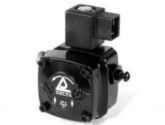Oil Burner VM Delta Pumps | Oil burners fuel unit with solenoid valve Type VM
The DELTA fuel unit is an efficient modern oil burner pump with a compact design and since its mounting flange, hub, and shaft sizes are manufactured to international standards (EN 225), it can be fitted to every oil burner.

Features
- High suction capability.
- Suitable for one or two-pipe systems.
- Self-priming.
- Reliable pressure and positive cut-off.
- Solenoid valve incorporated.
- Special rotary shaft seal.
- Silent operation.
- Low power absorption.
- Easily installed and adjusted.
- Pressure and vacuum gauge ports.
Applications
The DELTA fuel unit type VM is designed for pumping oil in high-pressure oil burners and transfer pump applications.
Operation
The VM fuel unit consists of a pump, solenoid valve, filter, and pressure regulator valve housed within one casting. The pumping action is obtained from two spur gears (2), one of which is connected to the drive shaft(3).
The pump casting provides the various oil ways, for the suction (6), return (5) and nozzle (9) ports. Pressure (8) and vacuum (7) gauge ports are also provided. The VM unit is available in two pipes and one pipe version. Both versions are self-priming.
On startup, the rotating gears purge the air from the suction chamber, through a vent groove in the piston to the return line in two pipe version, and through the nozzle line (after the solenoid valve opening) in one pipe version. On initial commissioning, it is possible to bleed the air more quickly, through the pressure gauge. Because a vacuum now exists oil, due to atmospheric pressure enters the suction chamber through the filter.
From the suction side, the gears pass the oil to the pressure chamber, where it comes up against the head of the piston. Due to the build-up of pressure, the piston is forced back against the pressure regulating spring. The flow of pressurized oil is interrupted by an incorporated solenoid valve (10), and can, therefore, be opened following the start of the motor (pre-purge), or interrupted before stopping the motor itself (instant shut off of the flame preventing the nozzle dripping).
The excessive oil is charged to the return side (or by-passes in the one pipe version). It will be realized of course that the spring tension, which is varied by the regulator screw (1), regulates the pressure of oil required.
The pump can be converted from the single-pipe version to the two pipe version, fitting the by-pass plug (4) in the return port.
